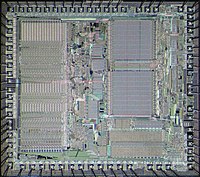
Photo from wikipedia
OBJECTIVE This study was designed to evaluate the effects of a modality change on vigilance performance to determine whether depletion of modality-specific resources contributes to the vigilance decrement. BACKGROUND Resource… Click to show full abstract
OBJECTIVE This study was designed to evaluate the effects of a modality change on vigilance performance to determine whether depletion of modality-specific resources contributes to the vigilance decrement. BACKGROUND Resource theory accounts for the vigilance decrement by arguing that the demands of vigilance deplete limited information processing resources. Research indicates that both supramodal and modality-specific resources are involved in vigilance, but it is unclear whether the vigilance decrement is due to depletion of supramodal resources, modality-specific resources, or both. If depletion of modality-specific resources contributes to the decrement, changing the modality of a vigilance display should improve vigilance performance after a decrement. METHOD Participants completed a 50-min vigilance task beginning in either the visual modality or the auditory modality. After 40-min, half of the participants experienced a sudden transition to the other modality; the remaining participants did not experience a modality change. RESULTS Performance declined over time and was generally superior in the auditory modality. Changing modality from visual to auditory increased correct detections, whereas changing from auditory to visual decreased correct detections. Both types of modality change were associated with an increase in false alarms, and neither had an effect on workload or stress. CONCLUSION Supramodal resource depletion, rather than modality-specific resource depletion, is the most likely explanation for the vigilance decrement that can be derived from resource theory. APPLICATION Modality changes are not likely to counteract the vigilance decrement and may actually increase false alarm errors. Countermeasure development should involve identification of depleted supramodal resources.
Journal Title: Human factors
Year Published: 2022
Link to full text (if available)
Share on Social Media: Sign Up to like & get
recommendations!